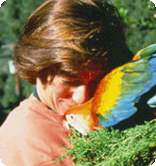Housing and humidity for a Blue-fronted Amazon?

Dear Phoebe, My Blue-fronted Amazon parrots live in a double-glazed conservatory. It has two doors, two windows, two skylights and the sides and roof are glass. I would be grateful if you would advise me about combining both temperature and humidity to keep my parrots comfortable. Both winter and summers weathers create different problems. During the summer the temperature is hotter inside the conservatory than outside. This year it was 85 degrees Fahrenheit causing dryness and low humidity. In the winter I keep the conservatory at 50 degrees Fahrenheit but I am unsure what temperature combined with humidity would protect the birds from a chill. The heating used is economy seven electric radiators and oil filled radiator. The heating dries the room, causing low humidity.
Please would you advise me what methods can be used to increase or decrease humidity?
I hope you are able to help resolve this problem.
Thank you, Sara Mylam

Hi Sara, Thanks for writing World Parrot Trust and for your desire to provide optimal environments for your Blue-fronted Amazons (Amazon aestiva).
First, I recommend that you immerse yourself in knowledge of wild Blue-fronted Amazon's habitats.
Read everything you can, including all the info and links on parrots.org. Including:
“Nesting success and hatching survival of the Blue-fronted Amazon (Amazon aestiva) in the Pantanal of Mato Grosso do Sul, Brazil”
Read full article
Abstract:
We studied the reproductive biology of a population of Blue-fronted Amazons (Amazon aestiva) in the Pantanal of Mato Grosso do Sul State, Brazil, between 1997 and 1999. Nesting occurred from August to December. We monitored 94 nests, which were found in trees of different sizes. Nesting trees were distributed in all major vegetation associations (floodplains, grasslands, scrub savanna, savanna, arboreal savanna, riparian forests, and pastures).
I find this research fascinating and hope you do, too, because it gives us vast amounts of inspiration as we provide optimal habitats for our flocks. Now that we know that wild Blue-fronted Amazons live and nest in “all major vegetation associations,” we can build habitats commensurate with their physiology.
Congratulations on the conservatory -- we have one, too -- a glass enclosed building, double-paned. It's a space dedicated to parrots and people sharing, but it's not inherently a "friendly" parrot environment. Modifications are needed, or so I've found. Additionally, it can be arid here in Santa Barbara, so, like you, I deal with issues of heat, humidity and sunlight.
We added retractable awnings to the outdoor roof of our conservatory and these are key. Decadent, I know, but pushing that button and having those awnings go out over the roof really helps the parrots' environment stay viable. We also have an indoor sprinkler system, which was easy to install and is simple to use. On hot days, it's a godsend.
With all the glass in the room, it can become weirdly reflective, so I use bamboo, rattan or other chewable mats which strategically drape and are affixed over cage sides and tops to allow for privacy and visual rest from windows and other forms of stimulation. Some of our parrots have three such shields: One or two on cage top, depending on how the sun at its brightest hits the cage; another on the side, depending on individual preference. So please, Sara, check your parrots and their cages / enclosures at various times throughout the day and provide full-body shade whenever they desire.
These natural fiber mats serve not only as privacy panels, but also as moisture holders and dispersers. Sprayed with water, moistened mats will cool the room for hours. Easily removable and cleanable, I find mats indispensable. If they get dirty, they get scrubbed, dried and re-used.
Additionally, we use three or more outdoor decorative movable screens that we simply prop against the windows where the sun hits hardest (this varies by season, of course) to cut down intensity. These cool the room considerably. Every day, as much as possible, I open the windows so that real natural sunlight and humidity enters the room.
On hot days, we open the windows plus drape thick wet towels on the outdoor screens. Now air entering the room is moist and cool.
Indoor plants with lots of foliage inside the room are beneficial water-retainers. Keep the area right outside the room also well hydrated with plants that provide shade, moisture, interest and loveliness. Potted plants can work -- just be sure they are tall and robust enough to provide shade. Keep these areas hydrated and keep the windows open so the parrots have at least part of a sun-lit environment, too. Drenched plants, mats and screens, inspire parrots to get drenched, too.
Get-a-Grips (sold in WPT on-line store) by Star Bird, are perfect companions to hot rooms because they, too, can be sprayed down. The moisture released throughout the day helps reduce aridity. Our parrots and parrot room would be greatly impoverished without our Get-A-Grips.
Do use and maintain clean cool air humidifiers, too. I've found that reverse-osmosis (RO) water (available at stores that sell saltwater fish) keeps humidifiers clean and running great. I think 85oF is not too hot for Blue-fronted Amazons as long as the air is gently moving, humid and moist. Healthy parrots can also easily live in 50oF.
Finally, don't stress too much about all but the most drastic extremes. Scientists tell us that wild Blue-fronted Amazons inhabit a variety of habitats. Encourage a fully realized relationship between you and your flock so that you are all tuned in to each other’s levels of comfort, camaraderie and companionship. Stay open to signals from your parrots on what they like and use, where they go during different times of the day, and so forth. Keep tweaking the environment to make it better and better for them.
Last but not least, encourage your Blue-fronted Amazons to love bathing and showering. If you provide multiple water bowls or large shallow bowls (8 x 11 glass baking pans work) and they learn to get silly and wet in it, that's great! Lots of showers, misting, water bowl bathing, plant leaf bathing -- yay! That way, if you're stuck in traffic on a hot day, your parrots can be having a blast in their water bowls.
All best, Phoebe Greene Linden and flock

































